Something I have not used this blog to talk much about yet is Interactive Fiction. Games like the INFOCOM line were one of my first starts in computer gaming. I bought my Commodore 64 after much research so I could make arcade games on it in BASIC without having to burden myself with learning too much about Assembler and the minute details of the operating systems involved.
I bought it so I could code a game in BASIC with movable sprites, that played like Q*Bert. If I could do that, I would buy it. My research eventually narrowed down between the Atari 800 and Commodore 64, but the 64 won out due to its more robust sprite system and an audio chip that was ground-breaking at the time, and is still in use today in many machines.
And ironically, the first game I ever played on my own C64 was one I bought with it – Suspended. At the time, I bought it partly because it had this amazing box with a vacu-molded face staring out at you with eyes that were cut out, and the manual behind it had eyes printed on it so it looked like it was staring right at you.
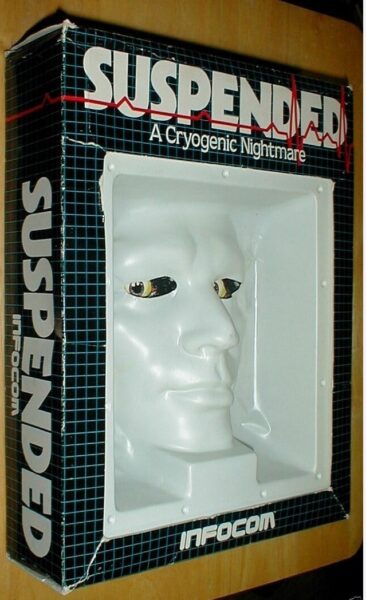
Cool, right? And I had heard of INFOCOM’s other early games and thought this will be awesome.
However, what I got was the Commodore re-packaging, which, while absolutely identical to the contents of the cool box, was inside a simple folder:
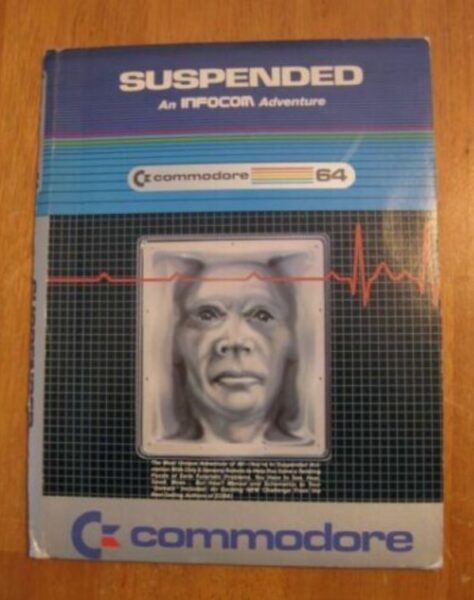
UGH! What a disappointment. Oh well, it’s not like having that box would be valuable, right? WHAAAAAT???
While this is top-end, it’s not unusual to see this for sale above the $1000 mark, and I haven’t seen it down below $500 in more than a decade.
Anyway, I find it still ironic that my first real game on my Commodore 64 was a text adventure, given why I bought it in the first place – to make arcade games, which were dear to my heart.
My first indication that the Interactive Fiction (as it is now called, but was then referred to as Text Adventure) games were so popular and engaging was when a friend called me up in a panic and said “Sean, I can’t get the chest open!” and I asked what the heck he was talking about. He said he was playing INFOCOM’s Infidel! and was trying to get – anywhere with it – and was stuck. I went over to his place (I had helped him set up his new system earlier in the week) and I saw what he was talking about. He was playing Infidel and was in the tent and didn’t know how to proceed. There was a chest with a padlock, and he couldn’t open it. So I looked around the game world a bit, found a shovel, and >hit the padlock with the shovel, and lo and behold, it broke the lock and he could open it.
That started a long love affair with INFOCOM games. A bunch of us would regularly get together and play these games, which I would say was probably more than the gaming world expected – that the interaction would not confine itself to the single player and the parser, but many friends getting together to bang their heads about trying to bludgeon their way through the many puzzles presented, except the genre kind of started out that way on campus mainframes, written and found by avid enthusiasts who loved to get together and pound their way through these games.
Then I bought game after game from INFOCOM until you can now see SOME of my collection here. (Some are missing, and I HOPE are in storage bins in my garage, but I am worried I may have lost them along the way, which would be particularly tragic because the only reason they are separated from this lot is that I had them all autographed by their Implementors. Mainly Steve Meretzky and Douglas Adams.

In 1984 or 1985 I started to write my own Text Adventure. I set it aboard a ship that resembled in layout the Klingon Bird of Prey, with two decks and wings with pods at the ends for weapons. A neck, and a bridge section like the head of a vulture. You were tasked with taking an infamous space pirate to court when his crew in their attack vessel found you and boarded you, killed your entire crew, and threw you into the brig, lest you prove useful. They then took over your ship, and the game begins when you wake up in the brig. You must escape and get your ship and prisoner safely to a starbase in order to win.
I called it Piracy. And you can read all about it here:
It was a two-word parser written in BASIC using the (then) INFOCOM screen view of a light gray background with black text for the game, and white text for the input line, and I implemented my own input routine, as the BASIC INPUT command allowed you to move the cursor off the command line.

I finished the game to my satisfaction, but it was very limited due to the parser limitations and memory space. I completely filled the 38+K of RAM in my C64. I literally could not add another sentence of text memory.
When I bought my Commodore 128 with double the memory (and actually more than double the BASIC space) I began to rewrite it more robustly, but never finished that project.
In the modern era, with the advent of INFORM, a great object-oriented language that compiles to the INFOCOM file format, in 2008 I took on the task of re-writing this old BASIC game in INFORM 6.0 which gave me the ability to use a very robust parser and implement many commands that would allow me to flesh out the world I had created and let people explore and play the game much better. I also enlarged the ship a bit (but not by much) and implemented all sorts of details I would never have been able to before. Yes, even toilets that work.
The project took about 9 months, and I had outside testers I found on the newsgroup for IF. They helped find bugs I fixed, but even today, it has some weird bugs. A lesson: When creating a raft of characters you intertwine into the back story through their belongings, don’t change their names in the last few weeks, because you will forget all of the mentions and leave the old names on some objects…. sigh…
I brought with me the combat system which players these days aren’t really all that fond of. You can encounter pirates as you wander your ship trying to repair damage and give it commands to get you to safety. They could shoot at you, and you could shoot at them. There was a damage stat, so if you got hit X times, you died. But there was also heal over time, and a med bay where you could also heal yourself. Once you hit a pirate, however, they are dead, and their body stays in the room you killed them. There were 10 in total, so it wasn’t completely random. Kill all 10 and you never encounter another one.
You could also fall ill and die of radiation poisoning if you’re not careful.Another thing modern gamers don’t much appreciate.
I entered the game in the 14th Interactive Fiction Competition, and the game came 5th in a field of 35, which was very impressive for my first effort, and even garnered some very positive reviews by the judges and players, not least of which was Emily Short, famed ground-breaking game writer herself, who has really been one of the key people keeping Interactive Fiction alive and fresh with innovative games no one would have thought to write before.
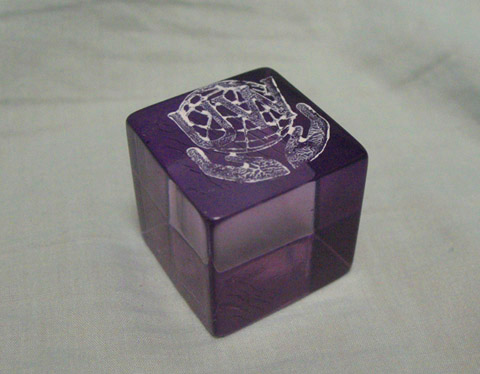
I took my game, and some “feelies” I made (an acrylic cube dyed purple with a logo painted on) to PAX East that year and met up with the IF writers in the area, and met Emily as well as several other prominent members of the group that was keeping the genre alive, though they did not know me then, and I had not yet entered that contest.
PIRACY 2.0 is available to play, and you can read all about it on my page here.
What prompted this post?
A year or two ago I backed a Kickstarter for a book called 50 Years Of Text Games.
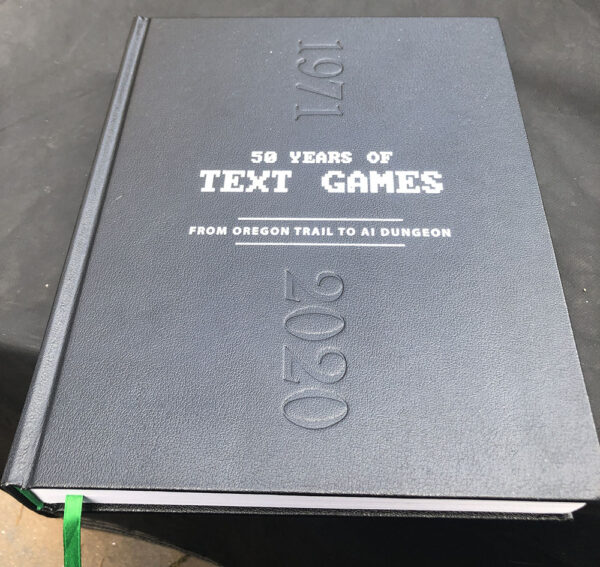
I got the book about a month ago and I’m reading through it now.
Lo and behold, what do I see on page 378?
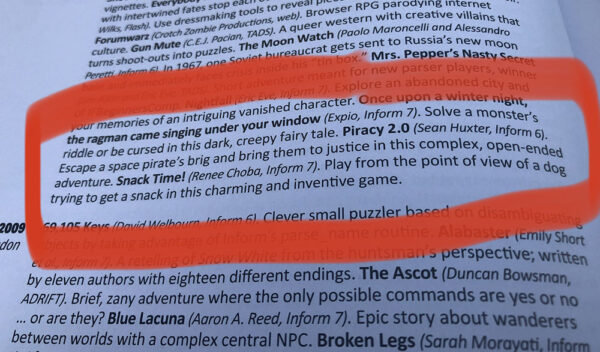
Oh hey!
A year or so later, I wanted to try out INFORM 7, which was a hugely different programming paradigm, and spent another 9 months writing a second game.
… which I entered into a competition and also came in 5th.
Out of a field of 6.
Oh well, you “win” some and you definitely lose some.
I also created “feelies” for the game, a wax-sealed letter in runes (which actually translate into English correctly, well, into English words which is not how translation works, maps, and a stone wolf-head amulet I carved with a Dremel and strung with a thin leather thong. For others, I created a FIMO replica of the amulet, but otherwise player “feelies” were identical to the one I made for myself, which you can see in the above shelf picture, in the white shadow box.
People did not like my forced game dynamic, and I think in the short time allotted for judges to play the game, they did not necessarily explore the people enough. I imbued each person with stories, memories, even jokes that you can uncover by talking to them. You could also REMEMBER people and gain insight and story through your memories.
But this NPC interaction was not overly emphasized, you kinda had to discover it, but I did lead people with clues and hints, and there is a robust HELP system that even talks about how to do this. The story is so much more than the tasks you have to perform.
However, what really irked many players was that in Act III your village is invaded by sea-going barbarians, and you have to run for your life.
The game then goes on a rail that people hated. It forces you into the forest, along a singular path with an enemy on your heels. You would die if you lingered.
Then you get to a clearing which you are not allowed to enter. That is, earlier in the game you made a promise to a forest fairy not to ever come back to her clearing, but you see no choice. You stand and fight futilely or you break your promise. What do you do?
And people hated hated hated that.
Me?
I kinda still like it.
And that’s the lesson for today, and it relates to any creative activity from writing, art, music, games, dance. Any form of creation:
Write what you want to read, and who cares if anyone else likes it? If they do, that’s a bonus, but not in itself a reason to write.
You can see both of my IF games at the Interactive Fiction Data Base, here.

